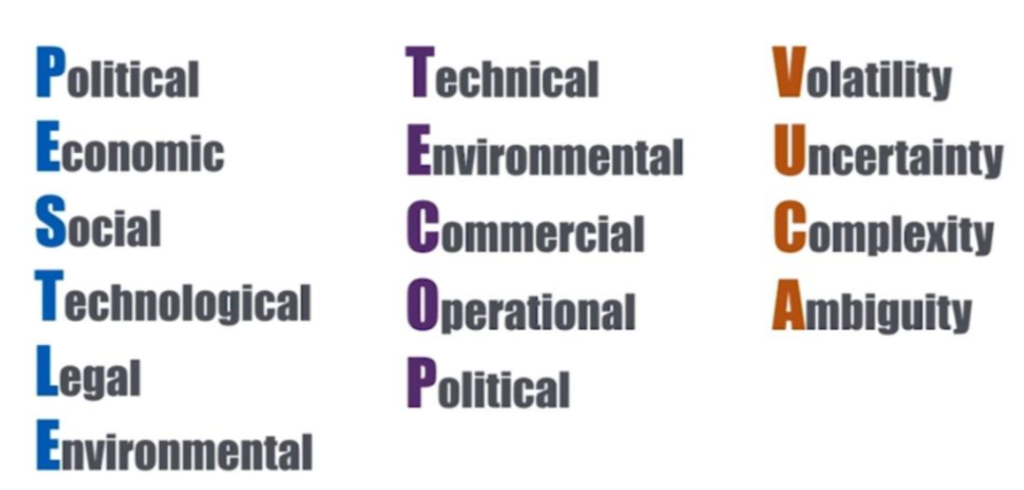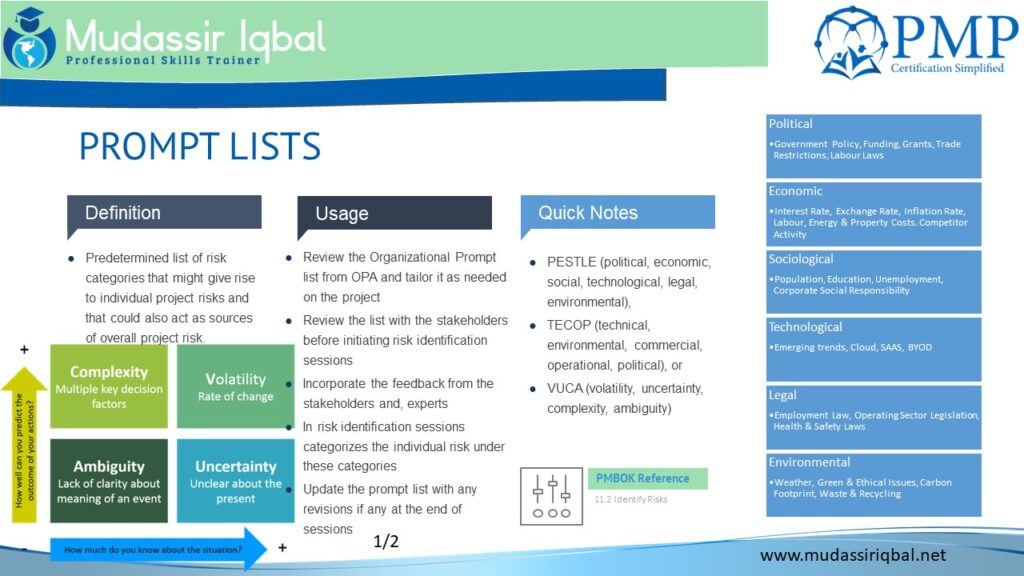In the fast-paced and unpredictable world of business, staying ahead requires a keen understanding of the forces that shape our environment. As organizations strive to make informed decisions and minimize risks, three essential frameworks come to the forefront—PESTLE, TECOP, and VUCA

Let’s delve into the intricacies of PESTLE’s political, economic, social, technological, legal, and environmental factors, dive into TECOP’s technical, environmental, commercial, operational, and political dimensions, and unravel the complexities of VUCA—volatility, uncertainty, complexity, and ambiguity
- PESTLE: Political, Economic, Social, Technological, Legal, and Environmental analysis.
- TECOP: Technical, Environmental, Commercial, Operational, and Political risk assessment.
- VUCA: Volatility, Uncertainty, Complexity, Ambiguity challenges.
PESTLE
PESTLE is a strategic analysis framework used to identify and understand the external macro-environmental factors that can influence an organization’s operations, projects, or decision-making. By considering the following factors, businesses can assess opportunities and threats, and adapt their strategies accordingly.
- Political Factors: These include government policies, stability, trade regulations, and political trends. For example, changes in government regulations on data privacy may affect how companies handle customer information.
- Economic Factors: Economic conditions such as inflation rates, interest rates, GDP growth, and exchange rates impact business operations. For instance, a recession may lead to reduced consumer spending and affect demand for certain products or services.
- Social Factors: Social factors encompass cultural trends, demographics, consumer behavior, and lifestyle changes. An aging population, for instance, could influence demand for healthcare services and products.
- Technological Factors: These refer to technological advancements and innovations that affect the industry or organization. The adoption of AI and automation can revolutionize manufacturing processes.
- Legal Factors: Legal considerations involve regulations, laws, and compliance requirements that businesses must adhere to. Changes in labor laws may affect employee-related risks and costs for businesses.
- Environmental Factors: Environmental factors include sustainability practices, climate change, and ecological impact. Businesses may face increasing pressure to adopt eco-friendly practices due to environmental concerns.
Wikipedia did provide a wide variety of variations such as SLEPT, STEPE, STEEPLE, STEEPLED, DESTEP, SPELIT and even STEER.

TECOP
TECOP is a risk analysis framework used to assess and manage risks in projects or businesses.
- Technical Risks: These risks relate to technical aspects such as technology failures, software bugs, or challenges in implementing new technologies.
- Environmental Risks: Environmental risks pertain to natural disasters, climate changes, and ecological factors that could impact the project or business operations.
- Commercial Risks: Commercial risks are related to market dynamics, competition, pricing, and demand. For example, changes in consumer preferences may affect sales and revenue.
- Operational Risks: Operational risks involve risks associated with day-to-day operations, such as supply chain disruptions, equipment failures, or process inefficiencies.
- Political Risks: Political risks are associated with government policies, changes in regulations, and political instability that may affect business operations or investments
VUCA
VUCA is an acronym that represents the four characteristics of the modern business environment—Volatility, Uncertainty, Complexity, and Ambiguity.
- Volatility: Refers to the rapid and unpredictable changes in the business environment. Economic shifts, technological advancements, or market fluctuations can cause volatility.
- Uncertainty: Indicates the lack of predictability and clarity about future events or outcomes. Uncertainty can arise from changes in consumer behavior or regulatory landscapes.
- Complexity: Signifies the intricate interplay of various factors and the multitude of variables that influence business decisions. Managing complex supply chains is an example of dealing with complexity.
- Ambiguity: Relates to the existence of multiple interpretations or the lack of clear information. Ambiguity can be seen in situations where decision-makers face conflicting data or divergent viewpoints.
The Usage PESTLE, TECOP, and VUCA
PESTLE: Analyzing the Landscape
The first step towards navigating uncertainty is conducting a comprehensive PESTLE analysis. Let’s imagine a retail company planning to expand its operations into a new country. Through PESTLE, they assess the local government’s policies and regulations (Political), evaluate the economic conditions and market trends (Economic), consider cultural and demographic factors (Social), analyze technological advancements (Technological), ensure compliance with local laws (Legal), and address environmental sustainability practices (Environmental). Armed with this insight, the company can make well-informed decisions and develop tailored strategies to tackle potential challenges and leverage opportunities in the new market.
TECOP: Mitigating Risks Proactively
In a rapidly evolving landscape, managing risks becomes crucial for business success. Enter TECOP—a comprehensive risk assessment toolkit. Let’s take the example of a technology startup planning to launch a cutting-edge product. By utilizing TECOP, the startup identifies technical challenges, such as potential software glitches (Technical), assesses the environmental impact of the product’s lifecycle (Environmental), analyzes the commercial viability and market competition (Commercial), evaluates operational inefficiencies (Operational), and considers the influence of regulatory changes on product deployment (Political). Armed with a comprehensive risk profile, the startup can take proactive measures to mitigate potential pitfalls and build a robust foundation for successful product launch and growth.
VUCA: Embracing Agility and Innovation
The business world is no stranger to Volatility, Uncertainty, Complexity, and Ambiguity—collectively known as VUCA. Instead of fearing these challenges, organizations that embrace VUCA as a reality can foster agility and innovation. For instance, let’s envision a financial services company seeking to navigate a volatile market. By acknowledging the uncertainty of economic fluctuations (Volatility), adapting to rapidly changing customer preferences (Uncertainty), addressing the complexities of digital transformation (Complexity), and embracing ambiguity as part of emerging trends (Ambiguity), the company can proactively design flexible strategies
- Brainstorming sessions: To generate creative ideas and solutions.
- Interviews: To conduct structured and comprehensive information gathering.
- Workshops: To guide participants through specific topics or problem areas.
- Problem-solving sessions: To ensure all relevant aspects of a problem are explored.
- Strategy development: To prompt discussions on critical strategic points.
- User research: To gather insights and feedback from users.
- Innovation sessions: To inspire innovative thinking and new perspectives.
Further Readings
Some Changes to Risk Identification: PESTLE, TECOP and VUCA, oh my! (projectmanagementforum.net)

